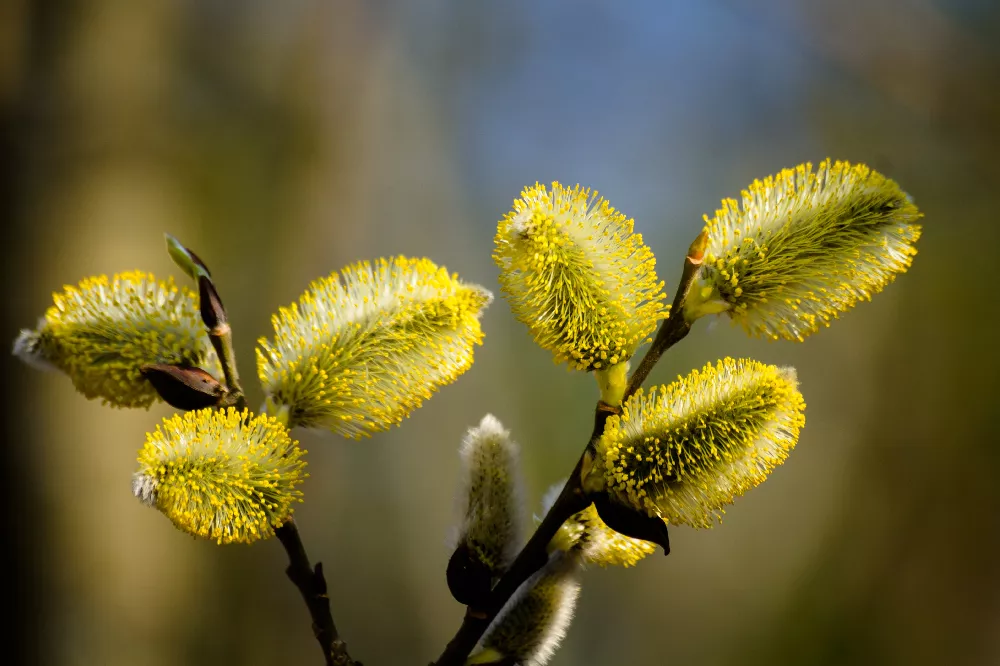- Home >
- Shrubs and Bushes >
- Weeping Pussy Willow
Weeping Pussy Willow for Sale - Buying & Growing Guide
Pussy willows, or Salix discolor, are native to northern North America. The small trees can be pruned to serve as shrubs and are prized for the soft, furry catkins that give them their name. Those catkins are one of the first signs of spring in many regions, and they are often used in floral arrangements to provide texture and color. Pussy willows should be sited carefully in soil that retains moisture but at a good distance from septic systems and underground lines, to avoid interference from the invasive roots.
- Noted for their furry catkins.
- Can be pruned to serve as a tree or bush.
- Roots are widespread and can damage pipes and underground lines.
Enter your zip code to find nearby stores that may carry this plant.
Plant Care
Sunlight
Pussy willows thrive in full sun, about six to eight hours a day, but can also be grown in partial shade.
Watering
Pussy willows like consistently moist soil. They are best grown in a boggy or wet area.
Fertilizing
Adult trees do not need supplemental fertilizer but benefit from the yearly application of compost.
Planting and Care
Planting instructions
In the wild, pussy willows are wetland plants so it is best to plant them near a pond or stream, or in a region of your garden that does not drain well and stays boggy most of the year. They like wet, loamy soil with a neutral pH. To plant, dig a hole that is as deep as the root ball and twice as wide. Toss some compost into the hole and then place the sapling so that the top of the root ball is level with the ground. Fill in the hole with the soil you dug up, mixed with compost or leaf mold. Tamp down the soil gently and water generously.
Watering and nutrients
During your tree’s first year, it will need supplemental watering, about an inch to an inch and a half a week will do. After that, it may not need supplemental watering. You should monitor the soil, and if it appears dry, give it a watering.
Pussy willows do not need regular fertilizing if they are planted in good soil. A light feeding with a balanced, slow-release fertilizer in spring will give them enough of a boost. The plant also benefits from a layer of compost spread around the root zone in spring.
Pruning
Left unpruned, a pussy willow can grow as tall as 25 feet but most gardeners prune their plants, in early spring, to the height of a small ornamental tree or shrub. There are several ways you can do this. One is to prune for shape, trimming off the tops of the branches. You can also prune back all but one of the main branches and allow it to take on a tree form. You can even cut it back to the ground every few years and allow it to regrow but doing so will leave you without catkins for a year.
Pests, diseases, and animals
Pussy willow may experience issues with diseases such as powdery mildew, blight, leaf spot, and canker. Insect pests include aphids, scale, borers, and caterpillars of various types. Unfortunately, the plant is also a source of food for animals ranging from deer to rabbits, squirrels, and ducks. If you live in a region with bountiful wildlife, you may want to cover your pussy willow with chicken wire or fencing to keep animals away from it.
Harvesting
To harvest, cut the branches before the catkins are fully developed and bring them inside. Place in a vase of water in a sunny window. Male catkins are showier than females and are usually what you find at gardening centers. If you wish to harvest the catkins for dried flower arrangements, cut the branches after the catkins are opened, and bring them inside. Do not put them in water but leave them in a cool dark spot, like a basement, for several weeks and they should retain their shape and color.
Achieving maximum results
Salix discolor, the American pussy willow, is the type most likely found at the nursery but several other species of Salix may be worth looking for, depending on your preferences. Salix caprea, or goat willow, has larger catkins that mature to a bright yellow. A sub-variety, Salix caprea pendula, has weeping branches that make it a stunning ornamental tree for the garden. Salix cinerea, or grey willow, can grow up to 50 feet tall, and the catkins are mainly on the tips of the branches.
FAQs
Can I grow pussy willow in the southern U.S?
Pussy willow plants can generally be grown in the U.S. hardiness zones 4-9. If you are south of that, you may want to try growing a small specimen in a pot or giving your pussy willow afternoon shade.
Can I grow pussy willow from seed?
The easiest way to propagate a new pussy willow is by clipping a 1 to 16 inch branch from an existing tree. Pussy willows produce a rooting hormone when cut, so all you need to do is place the cut branch in a container of water until you see roots starting to form. Keep the container in a cool, shaded spot. Once roots have developed, transplant the branch to moist soil.
Are there any other concerns I need to know about pussy willows?
Pussy willows have weak branches prone to cracking and breakage. This may be an issue if you live in an area with heavy, winter snowfall. For this reason, many northern gardeners cut their pussy willows back to the ground every few years to allow fresh new branches to grow in the spring.
Compare Similar Products
Customer Reviews
The tree was in great shape and was not damaged. I think the price was a little high for the size and I found the same tree at Lowes and was a lot fuller and way cheaper. Overall I have always got good products from here I just hope they could be a little more competitive with other retailers.
It'full of leafs will they turn to pussy willows
I purchased it because it said delivery would not be until the end of March. I thought that would be perfect because the weather would be better & the ground would not be frozen, making it easier to plant. However it was sent a week or so later in February. I would have waited in purchasing if I knew it was coming so soon. I have it in a large pot until I can plant it outside. Looks healthy, nice size
The tree arrived in a healthy state, and seems to be settling in to it's new, large pot very happily. It arrived with green leaves, and only a few twigs snapped off during transit. It's even started to bloom since I received it (Atlanta, in early June)! The only thing about the plant that was unexpected, was that one side of the plant doesn't have any of the weeping branches coming off of it. I'm not sure if this is because it was grown against a wall, or with only one side receiving sunlight, but it currently looks a bit lopsided, since all the branches are weeping off of one half of the tree but not the other. I think that over time the tree will fill in the other side with new branches, it was just a bit odd. Overall happy with the plant, though.
Other then shipping delays due to COVID - the tree is perfect for the space I needed it.








